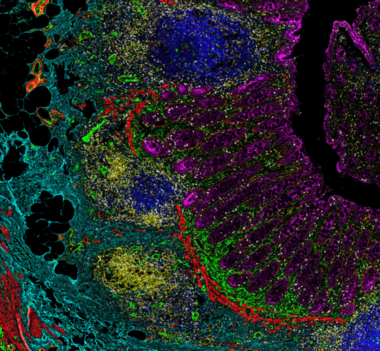Familiar with IHC?
Then you already know IMC.
If IHC is your comfort level, IMC lets you maintain that confidence in your research while moving it forward for insights you didn’t see coming.

Immunohistochemistry (IHC) has hit the hundred-year mark, or more, depending on who you credit with its conception. While we could argue that IHC started with the discovery of serum antibodies or with the ability to quantify an antibody-antigen reaction using dyes, the fact is that the technology has played an integral role in the pathological determination and diagnosis of disease.
Even with new technologies piling into the research toolbox, IHC has remained a foundation from which other approaches can be validated. But can old dogs learn new tricks? Absolutely.
Most tissue imaging approaches, including IHC, use tagged antibodies to detect the location of proteins in tissue sections. The variety in newer methods lies in the types of tags used, how these tags are bound and what antibodies they are bound to. Collecting more data from tissue is becoming routine with the adoption of modern fluorophores running a spectrum of color or other labeling methods such as those using metals.
While advances in imaging technologies abound, they typically require significant technical know-how to optimize multicolor workflows and stitch together various scans. But what about those that simply use what we already know and just improve on it?
Take Imaging Mass Cytometry™ (IMC™). The technology applies current IHC knowledge to sample preparation and staining, on the same slides. So, if you know IHC, you already know IMC. To improve upon IHC, IMC substitutes metal tags into a comparable workflow, allowing simultaneous detection of distinct signals across many more markers at one time. Subsequent visualization and analysis provide information on all of these markers, offering greater depth of insight.
The IMC workflow allows for high-plex protein detection from formalin-fixed, paraffin-embedded or frozen tissue sections in a manner similar to IHC but on a much larger scale. Instead of limiting detection to less than a handful of proteins, IMC empowers the detection to more than 40 markers in a single scan, at subcellular resolution. The equivalent data generated from IHC would take multiple cycles and sections to complete, not to mention much more time.
If IHC is your comfort level, IMC lets you maintain that confidence in your research while moving it forward for insights you didn’t see coming.
References:
- Publication: History of Immunohistochemistry
- Article: The single-cell pathology landscape of breast cancer
Note: In the Nature publication, you will find a reproducibility analysis and comparison of IHC and IMC.
Check out other blog posts
EXPAND YOUR BIOBANKING KNOWLEDGE
Luke Stewart, Director, Field Applications, and two special guests will be leading a workshop on biobank workstream processes at ISBER's 2022 Annual Meeting.
Join us at AACR 2022
Our technologies are well-suited for oncology research – focusing on gaining a better understanding of how the immune system responds toward cancer.
To automate or not to automate?
Considerations for when to automate, from common drivers to what you really should be thinking about.
Unless explicitly and expressly stated otherwise, all products are provided for Research Use Only, not for use in diagnostic procedures. Find more information here.



